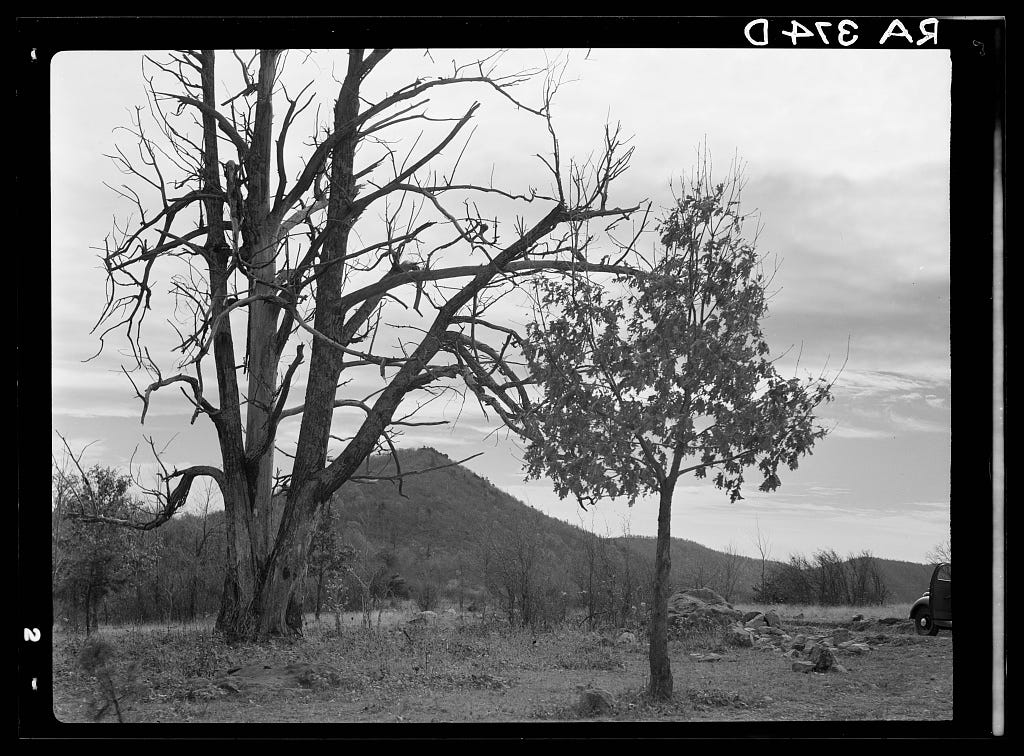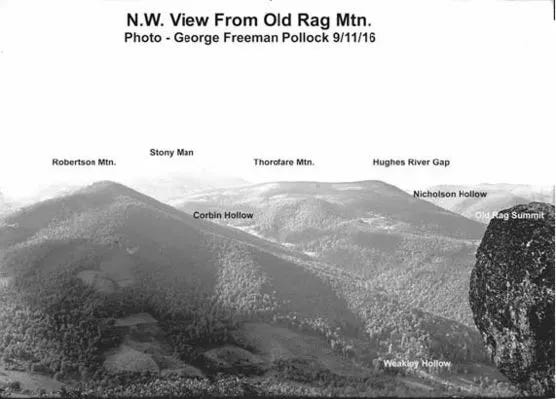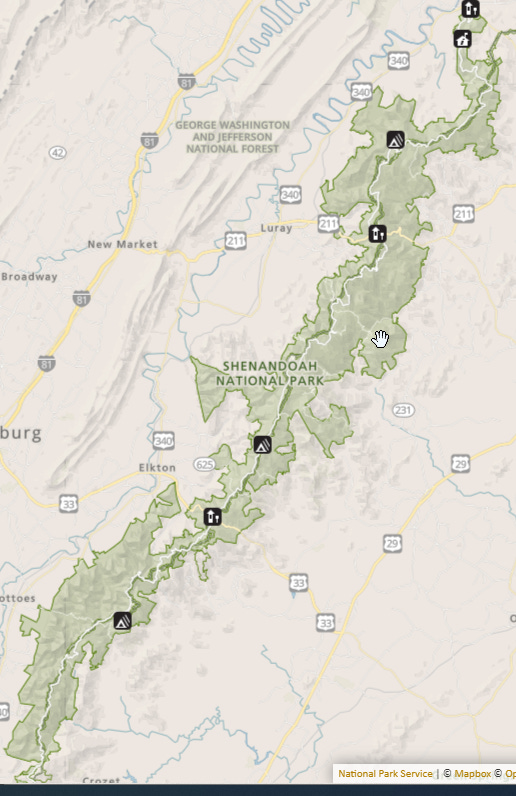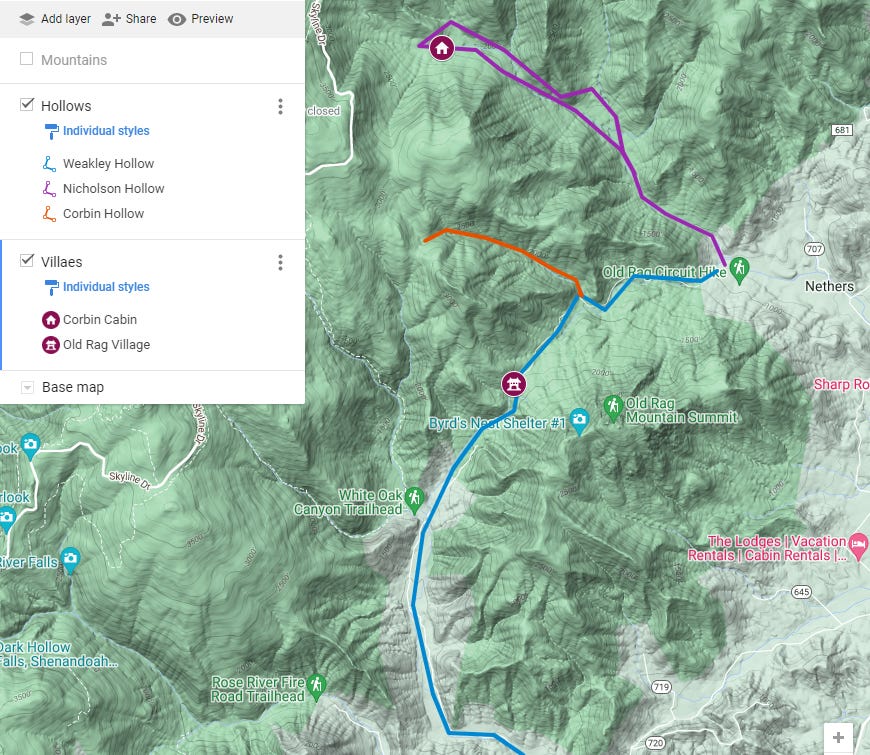Old Rag Mountain - Part I
forgotten lore and forgotten folk
The Holly Stone? Well, let me spin y’all a yarn from me ol’ da.
Y’see, back when my da was a youngster, so the tale goes, the holly-folk used to come to town, down from Ragamuffin Mountain way, to trade an’ barter an’ the like. They was wild-eyed and had a strange way ‘bout em like woodland creatures, but twere fair enough bargaineers though they held no truck with any kind o’ coinage - valued all their goods down to an ounce o’ liquor.
Any how, one day, this big band of ‘em comes to town haulin’ a massive piece o’ round stone with smoke curlin’ off it like some dragon’s egg–they was haulin’ it along a series o’ short logs that young’uns ran up to and brought ahead as the strong among ‘em hauled on thick braided ropes.
They march all the way up to the edge o’ town, an’ stop. They gathered together ahead of the stone, dirt under their nails and bits o’ tree-leavins in their hair.
O’course, at this point all the townsfolk are feelin’ right nervous and have assembled at the edge o’ town near Harald’s forge, an’ my da is right at the fore (him being but a small tyke at the time) so he has front-row seats to the whole show!
That’s when their leader–big bushy bearded feller–steps forth an proclaims to all in earshot that the Earth opened wide atop the peak o’ the Ragamuffin and belched out this stone, which the folk of Kin’s Holly (that being the place they called home) dragged here now as an offerin’ o’ eternal friendship twixt them an’ us ‘softfooters’, an’ that if the town is ever endanger, all we must do is break open the stone an the holly-folk’ll come.
Well, after that day no one has seen hide nor hair of the holly-folk, though if you ever make yer way through the forest (follow the old cart path that starts just over the ford) to the foot of Ragamuffin Mountain, I swear there are eyes watchin’ from the trees. Mayhaps it’s the holly-folk. Mayhaps something else.
- Edith Wendle of Stonetown
Folklore & History
Sometimes I plan the subject of my writing, and sometimes the subject plans me. For the past couple of weekends, I have gone on day hikes to a rag. Specifically, the mountain known as Old Rag. Which is, as you have no doubt asked yourself by this point, a funny name. Not quite as poetic as Wolffork Valley, but just as striking in its own way.
As are all place names.
Walk down any street, go on any hike, or interact with worlds external (or in some cases internal) to you, and you will encounter a place name. What’s in a (place) name?
Quite a lot, usually. For place names encapsulate both remembered and forgotten history, simultaneously donning a sobriquet to suit the times. A sublation, perhaps. But that’s not a path that I have the brain power to explore just now.
For now, let us delve into the history (both real and imagined) of Old Rag.
Raggedy Granite (old-style)
Old Rag Mountain sits more or less in the central chunk of Shenandoah National Park (about where the hand-icon is in the picture below), rising 3,238 feet / 1,001 meters above sea level
The name “Old Rag” supposedly comes from the rugged (or ragged) ridgeline that cuts across the sky in a jagged curve due to the exposure of the plutonic granite underneath the mountain. Known as Old Rag Granite (taking it's name from the mountain) the distinctive formations and standing stones dominate the upper third of the mountain and formed 1,000,000,000 (← that means 1 billion) years ago during the Grenville orogeny.1
That doesn't help us with where the name comes from, of course.
Alternate interpretations abound - as local enthusiast Reilly Tifft said in an interview, “the profile of the mountain looks like someone tossed a rag out after cleaning their car” - such that the true origin of the name may never be known. And that is just in English. Unfortunately, I have drawn a resounding blanks as to what the mountain may have been called by the Manahoac, one of the native peoples that likely inhabited this part of Virginia.2

Time for some speculation. On the etymological side, there are a couple interpretations. The adjective ragged means something like having a rough edge or broken texture, which fits with the rough edge of the mountain’s summit. On can almost hear the pithy comments–“that old ragged mountain? Oh yeah, me and Wilbert hiked it yesterday”–rolling off the tongues of Virginia locals.
I have an alternate theory, however, and it may take us a while to get there. The English noun rag comes from the Old English ragg (potentially meaning shaggy or bristly). There are 10 (TEN) different definitions of rag, which I included below after ripping them from Wiktionary.:
Tattered clothes (plural)
A piece of old cloth, especially one used for cleaning, patching, etc.; a tattered piece of cloth; a shred or tatter.
A shabby, beggarly fellow; a ragamuffin.
A ragged edge in metalworking.
A sail, or any piece of canvas (nautical slang).
Sanitary napkins, pads, or other materials used to absorb fluid3 (slang)
A newspaper or magazine, especially one whose journalism is considered to be of poor quality. (slang)
A poor, low-ranking kicker in poker.
A curtain of various kinds (theater slang).
A person suffering from exhaustion or lack of energy (dated).
I want you to remember definition number 3 - ragamuffin.
Hollows and Hollow Folk
A village once stood at the foot of the mountain - the village of Old Rag. Today, you can find an NPS sign at cross roads of the Old Rag Fire Road and the Weakley Hollow / Berry Hollow Fire Road. This is where we need to pause for a brief exploration of the word ‘Hollow’ - which is a term I was not familiar with - as it will become relevant in another paragraph or two.
‘Hollow’ is a regional term for a small, sheltered valley surrounded by mountains that usually has a waterway running through it (though not always).
As I was digging through the information available on the NPS website, I stumbled upon a fascinating survey of the folk that lived around Old Rag written by Dr. Audrey Horning before Shenandoah National Park was created in the 1930s.4 These people came to be referred to as "Hollow Folk", thanks to an eponymous book written by Mandel Sherman (a sociologist) and Thomas Henry (Thomas Henry), which cast these people as backwards, illiterate, and unintelligent thanks to their slowed social and mental development that SURELY came from living in isolated hollows5...which is, frankly, an absurd assumption to draw. Yeah, I can be biased on this platform. Yeehaw.
The caricatures of these people as primitive or uncouth may be the origin of the term “old rag” for reference to the village of Old Rag - not ragged, but ragamuffin. I could be completely off base here, but in Sherman and Henry make no mention of the mountain of Old Rag, leading me to the idea that the mountain may take its name from the village, not the other way around, and the old ‘ragamuffins’ that lived there.
Then again, that has about as much feet (if not less) than ‘old ragged mountain’ theory, but observer names have an unfortunate way of sticking especially given that all the people who could have told us what THEY called the mountain are dead and gone.
So were the Hollow Folk really all that raggedy? Probably not. In a survey of the material culture from 88 historic sites across the 2500 acres of Weakley, Nicholson, and Corbin Hollow, Horning notes that the “‘hollow folk’ owned the same types of goods which are found on archaeological sites of the same era throughout the United States—many no doubt originating from the Sears and Roebuck Company,” which directly contradicts the harsh caricature that Sherman and Henry paint of these so-called primitive folk.

Ok, so. What is the significance of these three hollows anyhow? Well, basically nothing now - they are all national parkland. But they USED to be people’s homes. The photograph above and the maps below show the approximate locations of Corbin, Nicholson, and Weakley Hollow relative to Old Rag.
Weakley Hollow, according to Horning, is a narrow valley that rings the Western side of Old Rag, separating it from the rest of the Blue Ridge (that Old Rag Granite is pretty stubborn and geologically distinct, or so they tell me).6 Scotch-Irish settlers moved in during the late 18th century, Weakley Hollow cradled the village of Old Rag, which had a post office, two stores, a school, and TWO churches (religion is nothing if not the long yoke of Western civilization). Weakley Hollow was the most connected of the three hollows thanks to a through road, which allowed the commercial operation of "sawmills, gristmills, and distilleries."7 These days, you tramp along the Weakley Hollow Fire Road after descending from the summit of Old Rag.
Nicholson Hollow was populated in a similar timeframe–perhaps 20 years or so after Weakley Hollow according to the historical record–as the fertile land around the Hughes River drew farmers to the hollow, who subsequently engineered terrace slopes to a degree that hollow farmers were producing surpluses in the nineteenth century.8 Today, Nicholson Hollow is an alternate hiking trail to Old Rag that cuts up through the hollow, following the Hughes River.
And what of Corbin Hollow? According to Horning, Corbin Hollow “did not evolve into a distinct community until the establishment of the nearby Skyland resort in 1886. Families relied upon wage labor and craft sales at Skyland, leaving themselves wide open for disaster when the Depression struck and the cameras of park promoters began clicking” – and that is exactly when Sherman and Henry begin their survey of the Hollow Folk.9 It does make for a lovely hike these days, with the trailhead beginning off of the Weakley Hollow Fire Road.
These days, Old Rag is a wonderful day hike, and you can see all three hollows (and hike all three!) from the summit, though most traces of habitation have been carefully removed or left to crumble as relics of a mostly forgotten past.
That is all we have time for today, and I think I have rambled on long enough. Next week we will dive into an exploration of how we could incorporate the murky history of Old Rag into a TTRPG, perhaps even playing with unreliable narrative history…who knows!
Til then, keep on dreaming.
N
Paul Hackley, “A Hiker's Guide to the Geology of Old Rag Mountain, Shenandoah National Park, Virginia,” USGS open-file report 00-263, 2000, https://pubs.usgs.gov/of/2000/of00-263/.
If you don't know what the Grenville orogeny is, that's ok, neither do I, but it is significant to our purposes as we can understand where this granite comes from and why Old Rag is such a striking mountain. In brief, most of the other mountains around Old Rag are not underlain with the same granite. In a mountain range as old Appalachia, this means that after hundreds of years of erosion, Old Rag stands tall while it’s compatriots have withered upon the vine of time.
I’m drawing on Wikipedia here, but I also found this wonderful letter titled “The Mountains Whose Name is Gone”…a proper reminder of all the knowledge and lore that we have lost and, regrettably, forcibly erased.
For those of you that read footnotes, the actual text on Wiktionary is ‘menstrual discharge’ which I changed since a rag can ostensibly be used to absorb most kinds of fluid and other discharges (not sure why calling out menstrual discharge was necessary, but here we are).
I don’t have time to dive into the full history of the park, but there is a plethora of resources available on the NPS website.
Audrey Horning, “Mountain Settlements: Survey of Rural Mountain Settlement,” National Parks Service (U.S. Department of the Interior), accessed March 5, 2023, https://www.nps.gov/articles/mountain-settlements.htm.
ibid.
Though important note here, especially on distilleries, that there was a time when “whiskey was the one commodity that had a standard value and all the mediums of barter and exchange, such as corn, salt, tobacco, etc., were valued in accordance with the amount of whiskey they could fetch. When coin was almost unknown...a whiskey still was as necessary as a grist mill” (from Pennsylvania Agriculture and Country Life, p. 290, found in Thoughts on Whiskey). Perhaps the hollow folk had no need for coin when liquor made a good enough medium of exchange…
Audrey Horning, “Mountain Settlements: Survey of Rural Mountain Settlement,” National Parks Service (U.S. Department of the Interior), accessed March 5, 2023, https://www.nps.gov/articles/mountain-settlements.htm.
ibid.
For further reading on Corbin Hollow, Dr. Horning has a wonderful essay on the displacement of pre-park residents in the Old Rag area (and in the Blue Ridge more widely) titled When Past is Present: Archaeology of the Displaced in Shenandoah National Park.





